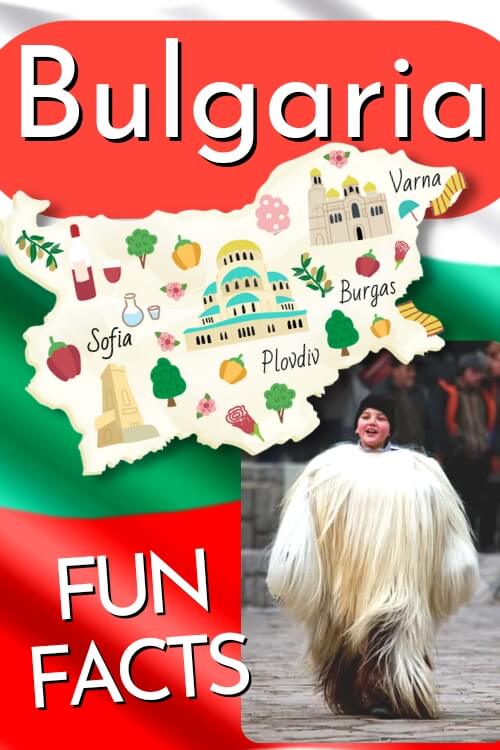We have traveled to Bulgaria several times, and have always been pleasantly surprised by the food.
There are a few themes in Bulgarian cooking:
- Simple is best
- Veggies are important
- Cheese is king
Most dishes are seasoned very gently, and rely on the natural flavors of tomatoes, cheese, and other ingredients to do the seasoning.
The result is simple and delicious cuisine using a limited list of ingredients, but presenting it in many completely different ways.
Bulgaria is best known for multiple food items before anything else!
Here are some must-try Bulgarian foods:
Bulgarian White Cheese
Ah Bulgarian cheese. You will recognize it as feta, but it isn’t, and don’t accidentally call it that! (From experience.)
While Bulgaria does have more than one kind of cheese, the white cheese that resembles feta is simply called sirene, or “cheese.”
This creamy cheese tastes like the best feta you’ve ever had, and it is made from sheep’s milk.
You will find it on shopska salad, in banitsa, or alone at the breakfast buffet.

Shopska Salad
Shopska salad, banitsa, and rakia are hands down the most popular Bulgarian specialties.
No matter who you ask about what to try in Bulgaria, they will mention at least one of these three.
Shopska salad is similar to greek salad. It always consists of tomatoes, cucumbers, and cheese. It usually includes red pepper, but not always. Sometimes the red pepper will be pickled.
Shopska salad is usually served with olive oil and white wine vinegar, but I like to make it with seasoned rice vinegar.
Some people choose not to dress it at all!
The special Bulgarian cheese goes on top, either grated or crumbled.
Banitsa
Banitsa is a simple baked dish, made from rolling sheets of phyllo pastry with egg and Bulgarian cheese. Once a long roll is created, the banitsa is spiralled like a snail into a tight circle.

Once baked, the pastry has a light, somewhat spongey texture. This is a great food to have for breakfast, and you can get it from just about any pastry shop or cafe.
At New Years and Christmas, good luck charms are baked into the banitsa for guests to find.
If you were to ask what Bulgaria’s national dish is, people would fight over whether it is shopska salad, or banitsa.
Rakia
Not technically food, but still a “must try” in Bulgaria, is rakia.
Rakia is a very strong alcoholic beverage made from fruit. Across the country you will find many different varieties of rakia: Plum, pear, apricot, and more!
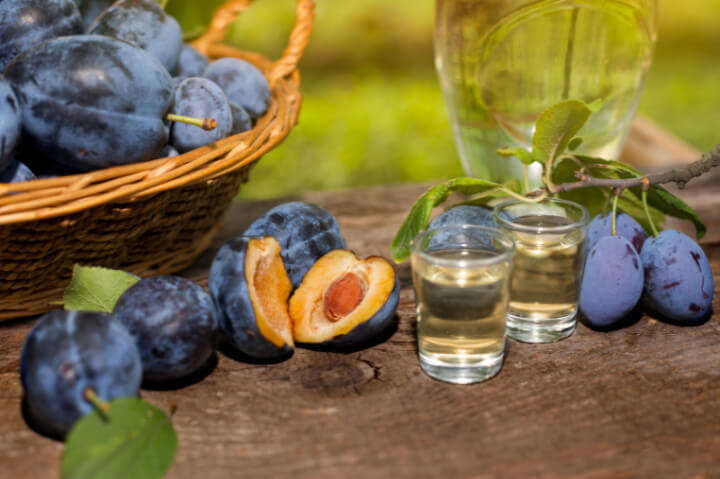
Rakia is often described as “fruit brandy”, but every country in the Balkans has their version of rakia, so that’s not exactly correct.
You will definitely be offered rakia if you spend time with locals, and it is often made in their own backyards.
At most cultural festivities, such as Kukeri or Iornadov Den, you will find rakia going around.
Bulgaria claims to be the birthplace of rakia, and it is their national drink.
They also make an anise-flavored rakia, called mastika.
Bulgarian Yogurt
Bulgaria (or specifically Bulgarian scientist Stamen Grigorov) has been credited with the discovery of the yogurt bacteria.
Even though the whole world can now make and enjoy yogurt using similar cultures, the Bulgarian government has patented their official yogurt culture. That’s right, the yogurt that you can get in Bulgaria is different than anywhere else in the world!
(Unless you order the culture online of course!)
Bulgarians use their special yogurt in all kinds of dishes, as you will soon see!
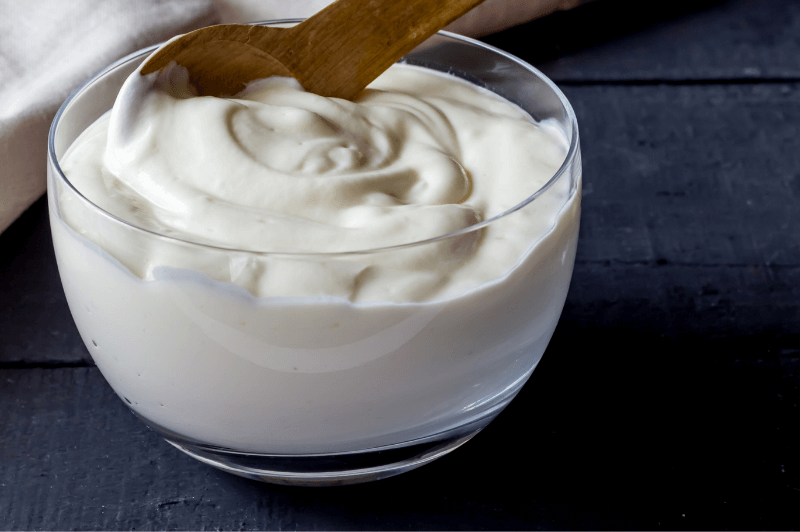
Bulgarian Breakfast
Sure, you could have banitsa for breakfast, but one of my favorite things about Bulgaria is the breakfast buffet.
Bulgarians love to serve a table full of small snacking foods for breakfast. This selection usually includes:
- Fresh tomatoes
- Peeled and sliced cucumbers
- Bulgarian cheese
- Toast and Nutella
- Hard-boiled eggs
- Salami
Sometimes I make this spread for breakfast at home, to hearken back to our Bulgarian adventures. It’s kind of like breakfast charcuterie.
Creamy Chicken Dish
I apologize in advance for the fact that I have no idea what this is actually called. The literal translation was “chicken chop with boletus.”

At most traditional Bulgarian restaurants there is a creamy chicken and mushroom dish, served with a side of roasted potatoes. Sometimes the potatoes are already in the sauce, and sometimes there is peas and/or corn.
I scoured the internet for the dish, and asked my Bulgarian sources, but none of them came up with the right dish.
It’s delicious anyways, and widely available, if not Bulgarian specifically.
Baklava
Okay, so baklava is technically Greek or Turkish (jury is still out), but being from the same region, Bulgaria of course has lots of this sweet treat.
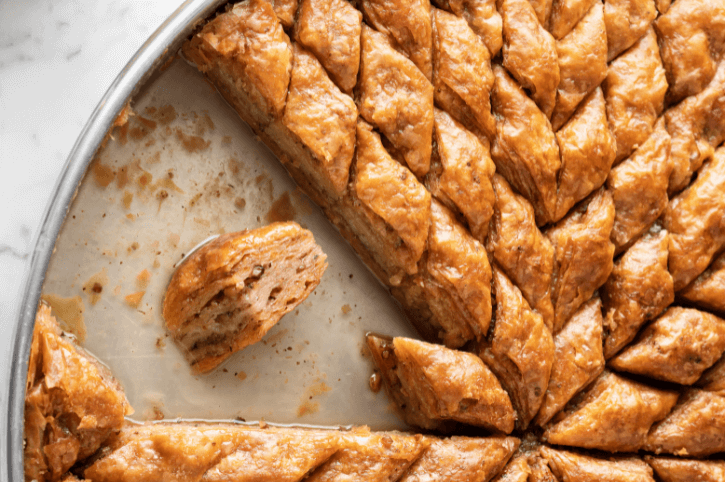
Bulgarian baklava is made the same way as usual, sheets of phyllo with walnut filling and then soaked in a delicious syrup.
Personally I prefer baklava to the banitsa, but in small doses!
Pizza
Another not-actually-Bulgarian food that you will definitely eat at least once on your trip, is pizza.
Of course every country has pizza, but Bulgaria has a LOT of pizza.
You can get it from hole in the wall to-go restaurants all over the country, and on almost every menu at a sit down restaurant.
Of course it is made in their own Bulgarian style, and that’s why it’s worth mentioning.

Pizza in Bulgaria is usually topped with their “yellow cheese” – which is called kashkaval – instead of mozzarella.
Pizza toppings include corn, pickles, smoked chicken, sardines, and more. Of course you can always get a traditional marinara pizza, and Bulgarians have a love affair with salami, so that will also be available.
How do I know you will eat pizza at least once?
Because if you find nothing else on the menu that sounds like a bit of you, there is always pizza!
Kebapche
Kebapche is sort of like a Bulgarian fast food. It is available like hamburgers are in North America.

Kebapche is usually pork, lamb, beef, or a combination, formed into a sausage shape and grilled. It is very simple in flavor, basically salt, pepper, and as much cumin as the meat can handle.
It is typically served with french fries.
I personally neither love or hate kebapche. They are usually a little dry, and don’t have a lot of flavor, but it’s not bad.
For the less adventurous, kebapche is probably a good compromise when trying Bulgarian food.
Kyufte
Kyufte (sometimes called kofta in English) is almost the same thing as kebapche. In this case onion is added to the mincemeat, salt, pepper, and cumin.
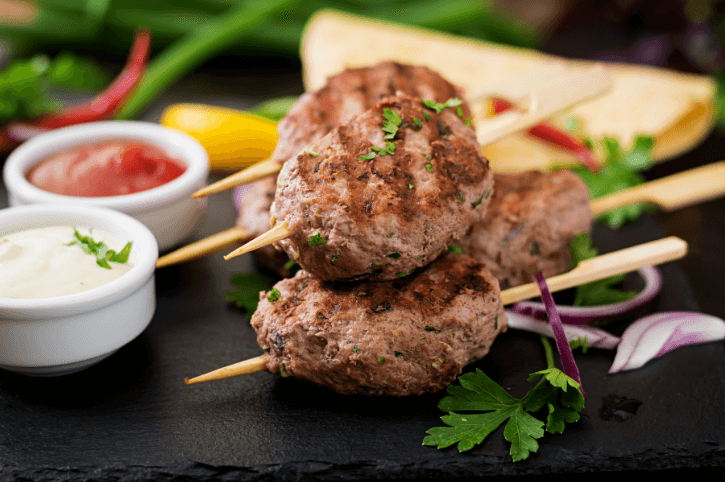
Afterwards the kyufte are shaped into meatballs and then flattened into a small patty and grilled.
Kyufte is also served with fries.
Katak
Katak is a spread or dip made with roasted red peppers, garlic, Bulgarian yogurt, and Bulgarian white cheese. It tastes like a red pepper version of tzatziki and is oh so good!
You can make katak at home super easily.

Supa Topcheta
Supa topcheta, or “meatball soup,” is a chicken or beef stock soup made with various veggies that you might find in chicken noodle. Sometimes there are also potatoes or rice.
Meatballs of pork, beef, or both are added to the broth before it is thickened with egg yolks. Yogurt and lemon juice are added to give the soup some kick, and it’s ready to serve.

Rose Flavoured Delights
Bulgaria is the largest exporter of rose oil in the world. If you spend time driving through the country side, you will see fields of roses.
If you spend time on Vitosha (or in any mall) you will see entire shops dedicated to rose products.
This pride spills over into rose flavored products, and you can try a lot of rose items in Bulgaria.

It’s not really for me, as I find the rose flavor impossible to separate from perfume, but it’s interesting to try.
You can get rose flavored jam, turkish delight, chocolate, wine, rakia, and more!
The foodie in your life will love to try these complex treats.
Honey
So honey isn’t exactly Bulgarian, but it is like the Frank’s Red Hot of the country, they put that s*** on everything. Bulgaria is one of Europe’s top honey producers, and their honey is said to be exceptional quality.
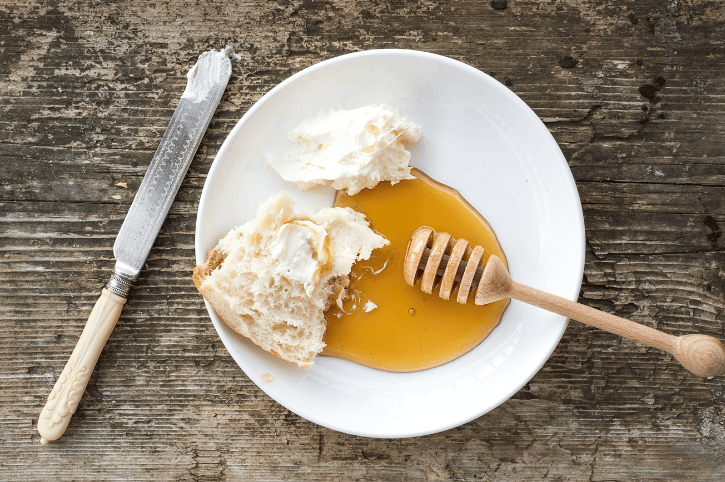
If you don’t want to pick up a jar of honey, you can find honey flavored treats all over the country, including rakia of course!
Try some medenki (honey cookies), Bulgarian yogurt with honey, or baklava with honey.
Gyuvetch
Gyuvetch is named after the traditional clay pot that it is baked in. You may have your own version of gyuvetch, as it is the Bulgarian way of getting rid of leftovers!
Typically this dish is made with lots of vegetables, cheese, a little meat, and an egg. The ingredients are seasoned with salt, pepper, paprika, and fresh herbs.
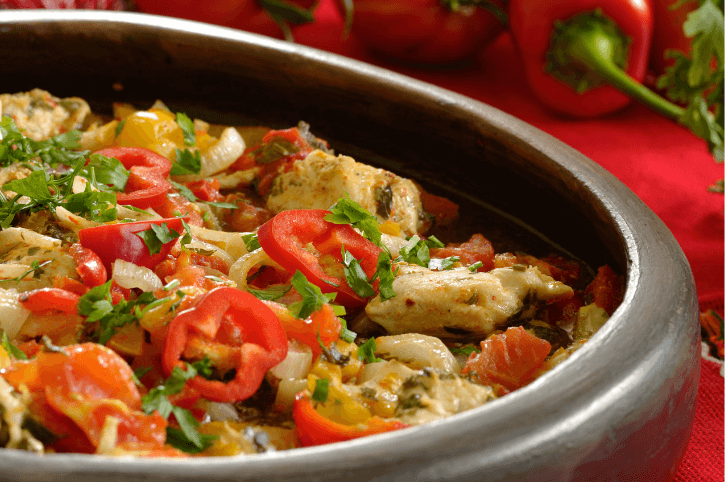
The vegetables (onion, tomato, cooked potato, and other seasonal veggies) are layered with sirene cheese, and leftover meat (sausage, chicken, etc.) and then finished with a cracked egg baked on top.
Of course if you see Gyuvetch in a restaurant the ingredients won’t be leftovers, but this is the traditional way to make it.
Green Walnut Jam
Less something to try at a restaurant, and more something to pick up at a supermarket, is green walnut jam.

I am not sure on the Bulgarian name, but I’m assuming it translates to “green walnut jam” because I haven’t found a special name for it.
This is a simple spread made from green walnuts and honey. It is usually used for dipping or spreading on bread.
Pine Syrup
Another interesting supermarket find, is Pine syrup. It’s exactly like maple syrup, but pine!
The flavor is interesting…like pine.
If you find it in the store it usually has a pine cone bobbing around in it!

Being from Canada where maple syrup is a pretty big deal, I was excited to try another trees sap.
I honestly can’t say if I like it or not, but it was fun to try.
Mish Mash
Mish mash is an actual dish in Bulgaria, and not just a term to describe anything in a pot!

This egg scramble is made with tomatoes, onions, peppers, and of course, a lot of Bulgarian cheese!
You can get mish mash in just about any restaurant that has Bulgarian food, or you could make it yourself at your apartment.
Moussaka
Moussaka is popular in Greece and Turkey, but Bulgarians have their version too.
This dish is almost like shepherd’s pie. Ground meat is cooked with vegetables (including lots of chopped tomatoes) and spices, then mixed with browned diced potatoes and baked.
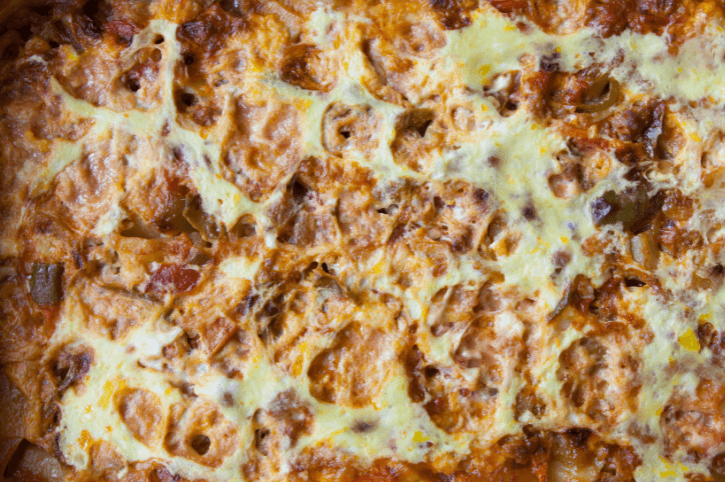
After cooking for a while, the moussaka is topped with a yogurt and egg mixture and returned to the oven where it forms a crust.
Yum!
Rare Burgers
Here in North America, burgers are pretty much always cooked through, not so in Bulgaria!
Bulgaria is the only place that I’ve ever eaten a medium rare burger, and I didn’t actually want to.
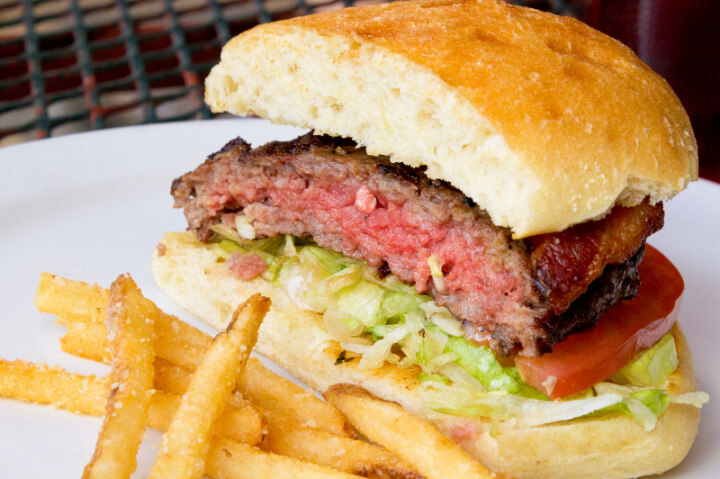
I was asked “How do you want it cooked?”
Surprised, I said “Well done…?”
“No.” Was the response.
“…Medium?”
“Okay.”
A typical Bulgarian restaurant experience in a nutshell.
Tarator
Tarator is a cold cucumber yogurt soup that is very popular in Bulgaria, usually as a starter.

It is flavored pretty much like tzatziki, with garlic and dill.
Our daughter had tarator once, but I actually never tried it because I’m not a fan of cold soups.
However I do know a lot of other people who have been to Bulgaria, and a lot of them liked it.
Bob Chorba

This is another simple Bulgarian dish that you could make at home! Bob chorba is a white bean soup in a tomato base with onions, vegetables, and seasoning.
It is said to have been staple in the diet of monks at Bulgaria’s many monasteries.
Doner/Dyuner
This will be a familiar street food for most people reading this list. Bulgaria has their own version of a kebab that is delicious!
In Bulgaria a doner is usually chicken, although you can also get “gyros,” which will be pork or beef.
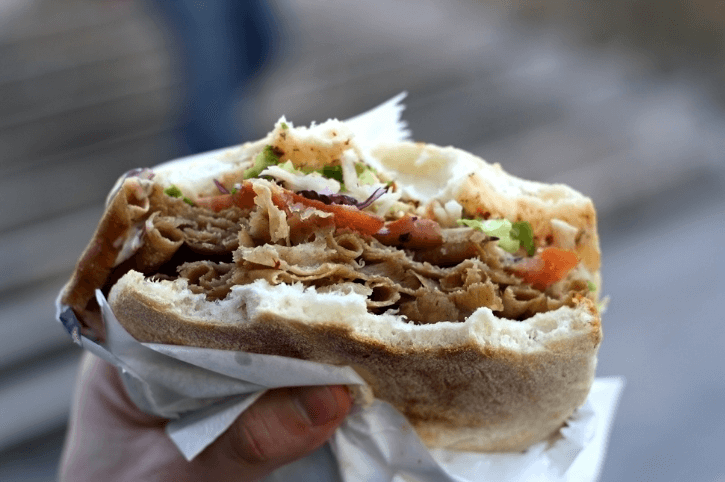
The kebab is wrapped in a flatbread and often served with fries right inside!
Snezhanka
Snezhanka, also knows as “Snow White Salad” is very similar to the cold tarator soup. It consists of yogurt, cucumber, garlic, dill, and usually walnuts.

It somewhat resembles coleslaw in appearance as it is heavily dressed with the yogurt, thus the name “snow white.”
I’m going to be totally honest and say that I haven’t tried this one. It just never looked that appetizing to me. Apologies! I’ll get it next time.
Palachinki
Palachinki is a simple but delicious Bulgarian crepe. These crepes are very similar to what you will find in other parts of the world, but they are filled only with butter and honey.
If you see palachinki on a menu, you won’t want to skip it!

Lyutenitsa
Lyutenitsa is a roasted tomato and eggplant spread, made with onion and red pepper. It’s very popular in Macedonia and Serbia too, and is available on some store shelves as a salsa or chutney.
Lyutenitsa is often served on toast, which you could top with Bulgarian cheese!
Kachamak
Kachamak is a simple polenta dish, made with spices and Bulgarian cheese.

Sometimes salami, prosciutto, or other meat is added. This is actually a breakfast food in Bulgaria (and North Macedonia).
I haven’t tried kachamak myself, because the texture is an issue for me, but among my American friends who went to Bulgaria, this dish was a hit.
Bonus: It is gluten free.
Kavarma
Kavarma is essentially a tomato based stew, made with cubed meat, spices, and wine.
The vegetables and other ingredients in Kavarma will vary around the country. In some regions it is spicy, in some it includes mushrooms and peppers.

Chicken and pork kavarma are the most popular versions.
Like the gyuvetch, kavarma is cooked in a traditional Bulgarian clay pot. Of course I am told this dish is excellent with rakia!
Chushki Burek
In Chuski Burek, red bell peppers are roasted and then peeled, stuffed with cheese, kashkaval (yellow cheese), tomato, and egg.
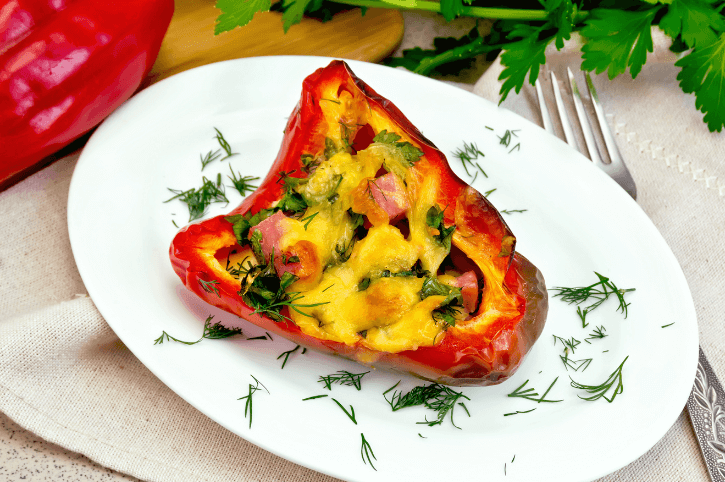
The peppers are then coated in egg and bread crumbs and then fried.
The resulting breaded stuffed pepper is served with a yogurt sauce similar to tzatziki.
Mekitsi
Mekitsi is something you are sure to enjoy! This is a Bulgarian fried dough similar to a donut.

A simple yeasted dough is formed into little patties and cooked in oil.
These are usually served for breakfast or brunch. You can have mekitsi sprinkled with sugar, or of course, there is a savory cheese version.
Caprese
Another not Bulgarian, but wildly popular in Bulgaria dish, is caprese salad.
Bulgarians love salads! It is not uncommon to have an entire page of salad options on a Bulgarian menu.
The most common salads to find are shopska, snezhanka (snow white), and caprese, so it’s worth noting here!
In Bulgaria, caprese salad is usually served with alternating slices of tomato and fresh mozzarella, folllowed by a drizzle of walnut pesto.

So good!
As someone who hails from a part of North America that will charge you an arm and a leg for fresh mozza, it’s hard to resist a caprese salad.
Kifla
Kifla is another dish that appears across the Balkans.
Similar in appearance to a croissant, a kifla is a breakfast bread that is formed into a crescent shape. Sometimes kifla is filled with Nutella, jam, or walnuts, but sometimes it is plain.
In Bulgaria, “kifla” is also a slang term that is similar to “bimbo” so perhaps don’t ask for a kifla unless you see it on the menu!

Bulgarian Foods Are Great
We really enjoy eating in Bulgaria! Although the food is different, there is nothing too strange about their meals, and you can always find something delicious on the menu.
Unlike some other communist countries where the food is very bland, Bulgaria manages to make flavorful dishes while still using very basic seasoning.
The best part is that everything is simple to replicate at home, so feel free to fall in love with one of these Bulgarian delights!
Want More?


